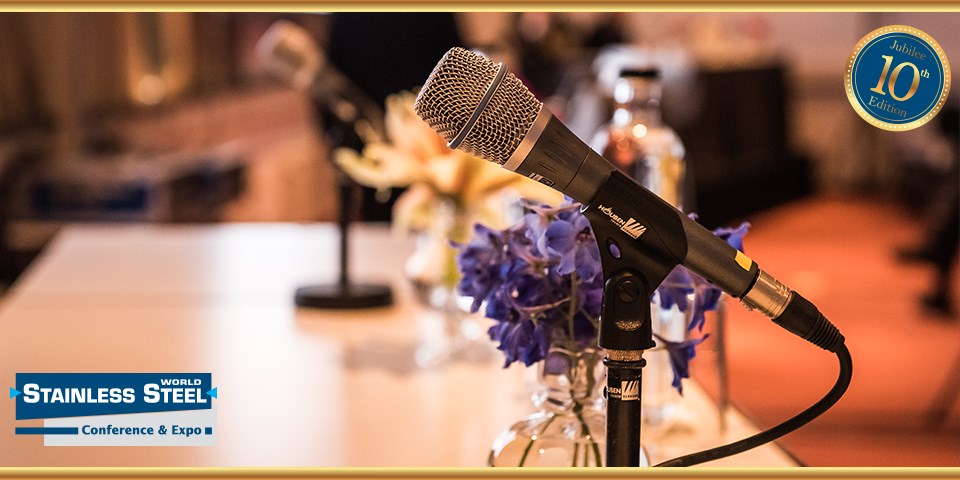Interview with Catherine Houska, TMR Consulting, Article by David Sear
Catherine, your presentation on the opening day will address sustainability. Can you indicate where you see a potential role for stainless steels?

It is first important to understand the breadth of the movement and its influence. Initial interest was primarily driven by buildings and infrastructure. Office space is not considered Class A without a high ranking using LEED, BREEAM or another rating system. In the US state of California, requirements have been adopted that will mean that every new construction or major building renovation project will have to be to the IgCC (International Green Construction Code) and therefore eligible for at least the lowest level of USGBC LEED rating. Increased emphasis on life cycle assessment and material longevity, resiliency, and low or no fume materials gives stainless steel an advantage.
From extraction through end use, every industry that uses stainless steel is likely to be touched by this movement in some way.
In practical terms, what has to happen for this to occur? For example, is it simply a question of raising awareness amongst architects and users or are there any technical or certification issues that need to be overcome?
Others would have to be company specific such as documentation of responsible raw materials sourcing. In addition to having the documentation publicly visible and, where logical, in databases used by practitioners, sales and marketing staff and customers need to be aware of it and educated about the relative sustainability advantages of stainless steel. There is an effort within ASTM to try to make it possible to add optional sustainability documentation requirements to materials specifications so that both requests and the availability of information are more easily communicated.
Secondly, the industry associations, producers and fabricators should become active in the organizations that are writing the standards and setting the direction for how sustainability will be defined. Through the efforts of Team Stainless and other metals industry partners at ASTM we have stopped highly problematic standards that were being developed on mineral depletion and criticality. We are proactively participating in standards development including initiating a Standard Guide for Recycling Considerations in Life Cycle Assessment (LCA), which will provide information on how each material should be handled by LCA practitioners. The goal is to create a central resource that can be used by LCA practitioners globally that is complimentary to the existing ISO standards.
Since it will be under the control of an international standard setting organization, technical verification of the information is assured. A stainless steel appendix is part of the ballot. There are many possible proactive standards that could be developed to define sustainability as it related to our industry. Participation in ISO, ASTM and voluntary rating systems like USGBC LEED is encouraged. Joining USGBC and other such organizations allows firms to use those logos to promote the sustainability of their products.
“Many large companies in industries that use a great deal of stainless steel, like food and beverage processing, pharmaceuticals, etc, have made corporate commitments to being more sustainable.”
What grades of stainless steels might be of particular interest?
Sustainability is not alloy specific as the best choice may vary with the industry and application. The broad range of possibilities should be considered as alloy families and product forms are added to regional or country specific Life Cycle Inventory (LCI) databases. LCI information is needed so that product manufacturers can do a full LCA assessment of their products. Additionally, it is important to make sure that these databases are populated around the world since the data must be specific to the region in which the stainless steel was produced. Alternatively, the data could be obtained from a producer’s EPD (Environmental Product Declaration). In regions with multiple producers of a material, industry average EPD’s are often developed by consultants.
Can you mention any success stories to date?
The initial primary focus of the sustainability movement was around buildings. Previous versions of the ratings systems did not focus on longevity and favored the materials with the highest early stage voluntary rating system development. For example, low VOC carpeting use garnered more points than zero emission stainless steel surfaces inside a building and renewable products like wood automatically received more credit even if they were held together with hydrocarbon based adhesives. In the more recent versions of the scoring systems, uncoated metal automatically gets credit as a zero emission material. Life cycle assessment is now an option for obtaining extra points with a minimum service life of 65 or 75 years.
That gives long life materials like stainless steel an automatic advantage – if the supplier can provide the necessary paperwork. There are many highly rated tall buildings being built with stainless steel cladding. The largest concentration may be in New York City.
The US is one of a growing number of countries that expects the bridges that expects bridges that they help finance to be designed for 100 years of service life. There has been a significant growth in stainless steel rebar use and increased interest in an array of highway and bridge applications from signage poles to guard rails to large structural sections for bridges.
To sum up, who do you think would benefit from attending your presentation?
Simply put, anyone in the stainless steel industry and those making products from it.
Conference topics
More details about all the keynote speeches, sessions, workshops, networking opportunities, etc, can be found via Advance Conference Programme.
Listen to Catherine’s full plenary presentation ‘Resiliency and sustainability create opportunities for stainless steel’ on November 27 at the Stainless steel World conference in Maastricht, the Netherlands!


